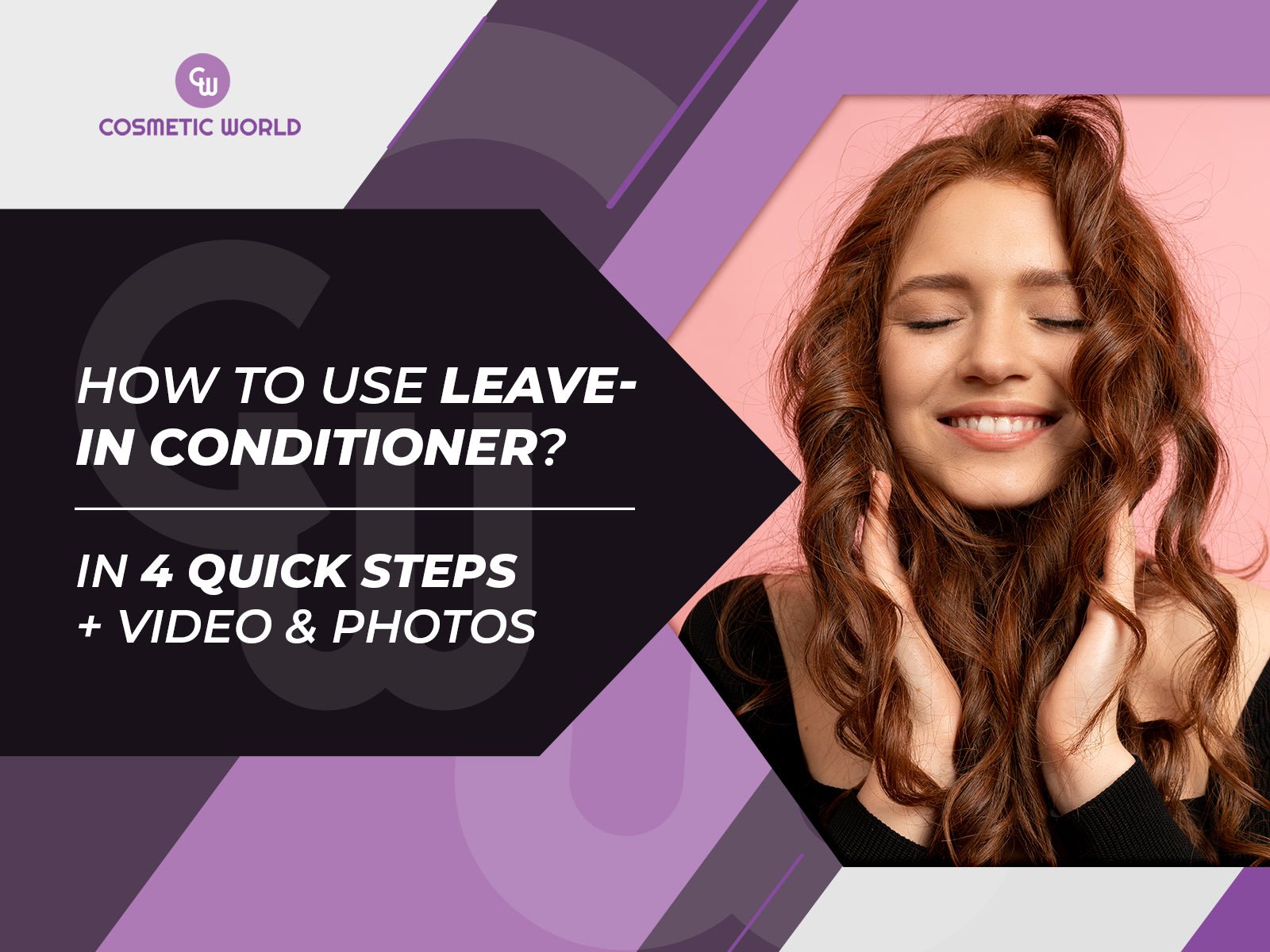In my experience with dry hair, a leave-in conditioner has been a game-changer for me. The purpose of this article is to share this experience and provide tips on how to incorporate it into your hair care routine for softer, healthier hair. You can learn how to choose the right conditioner for your hair type as well as how to apply and style it properly. The article on "how to use leave-in conditioner" will help you say goodbye to frizz and hello soft and healthy hair.
Table of Contents
- How to use leave-in conditioner?
- Short video demonstration
- Do you wash out leave-in conditioner?
- How long do you leave leave-in conditioner on?
- Results
- What is Leave-in conditioner?
- Which hair types can benefit from it?
- How to choose the best leave-in conditioner?
- Key benefits of leave-in conditioner
- When to apply the product?
- What is the difference between regular conditioner and leave-in conditioner?
- Is it safe to use leave-in conditioner?
- Is it safe to use leave-in conditioner on colored hair?
- Will the leave-in conditioner Leave Behind Any Residue?
- Best leave-in conditioners
- Conclusion:
How to use leave-in conditioner?
Because I wasn't sure how to apply leave-in conditioner properly, I struggled for a long time. If I used too much, my hair would be heavy and greasy, or if I used too little, I would see no results. In the end, I learned how to apply the conditioner correctly only after speaking with my hair stylist and conducting some research myself. After learning these techniques, my hair became more manageable, soft, and shiny.
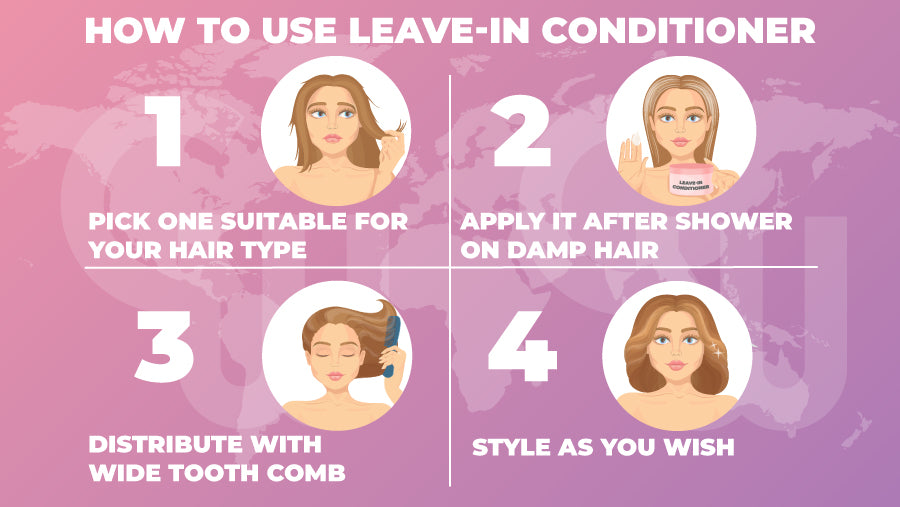
For a quick guide on how to use leave-in conditioner, here are some simple steps:
-
Make sure the conditioner you choose is suitable for your hair type and needs.
-
Wash your hair and dry it with a towel. Then apply leave-in conditioner to the mid-lengths and ends of your hair.
-
Ensure that the product is distributed throughout your hair evenly by using a wide-toothed comb or brush.
-
You can style your hair however you like.
PRO TIP: While using it avoid applying leave in conditioner to the roots of your hair. Natural oils accumulate at hair roots, so applying a leave-in conditioner there can make it look more greasy.
Short video demonstration
Do you wash out leave-in conditioner?
The short answer is "No". You shouldn't wash out this type of conditioner. Instead, you need to apply it after shampooing and leave it on the hair to provide ongoing conditioning. Make sure you apply it on a damp or barely wet hair (towel-dried). Thus, the hair shaft is able to absorb the product more easily.
How long do you leave leave-in conditioner on?
The leave-in conditioner is designed to remain in the hair for an extended period of time. That helps with ongoing conditioning and nourishment. Depending on your hair care routine and the product you are using, you will need to leave the product on your hair for a certain amount of time.
You can use it daily or occasionally as a deep conditioning treatment. Keep in mind that you should only use the amount recommended by the product label. Moreover consider the amo ntaccording to your hair length and thickness.
Results
What is Leave-in conditioner?
As an alternative to traditional conditioner, leave-in conditioner should be applied on towel-dried hair and left in. As a result, the hair becomes more manageable, softer, and healthier. It's important to apply it to damp hair after showeriTg. Thus, the hair shaft is more easily able to absorb the product.
You can use leave-in conditioner on any type of hair, whether it's dry, damaged, curly, or frizzy. As well as hydrating and repairing the hair, most of the time it also protects it from harsh UV rays. The product usually has a lightweight and non-greasy texture. You can also use it with other hair care products, such as gel or mousse, to enhance hold.
PRO TIP: Use a leave-in conditioner with added nourishing ingredients, such as argan oil or keratin, if your hair is particularly dry or damaged.
Which hair types can benefit from it?
Before using a leave-in conditioner, you should know your hair type. It's iportant because different hair types may require different care and may respond differently to certain products. Oily hair, for example, may benefit from a lightweight and oil-free leave-in conditioner, as a heavy or oil-based conditioner could weigh down and make your hair greasy. Alternatively, dry hair may benefit from a leave-in conditioner that is more nourishing and hydrating, since it can help to moisturize and repair hair.

Leave-in conditioners can be beneficial for a variety of hair types. Here are some specific hair types that may particularly benefit from using leave-in conditioner:
-
Frizzy hair: Helps control frizz and flyaways, making hair look smoother and more polished.
-
Damaged hair: Strengthens and repairs damaged hair, resulting in healthier, more resilient hair.
-
Dry hair: Hydrates dry hair, resulting in softer, more manageable hair.
-
Color-treated hair: Protects dyed hair from fading by containing ingredients that help prevent color loss.
-
Curly hair: Makes curls more bouncy and easier to style by defining and enhancing them.
-
Fine hair: Helps with adding moisture and hydration, enhancing volume, and reducing frizz and flyaways
-
Thick hair: It helps thick hair by protecting it from damage caused by styling tools, environmental factors, and other stressors, keeping it looking healthy and strong.
Additionally, leave-in conditioner can be beneficial for many other hair types, including oily hair, fine hair, and normal hair. Moreover it's best to choose a product based on your hair type and personal needs.
For example: I have dry, damaged hair, so I look for a leave-in conditioner that is nourishing and hydrating, with ingredients like argan oil or keratin. I also make sure to choose a product that is suitable for color-treated hair, as I dye my hair regularly.
How to choose the best leave-in conditioner?
As I choose a leave-in conditioner, I consider my hair type and concerns. Moreover I'm thitking about the ingredients, whether it is suitable for color-treated hair, its effectiveness from reviews, the price, and the packaging. Having this in mind, to choose the best leave-in conditioner, consider the following factors:
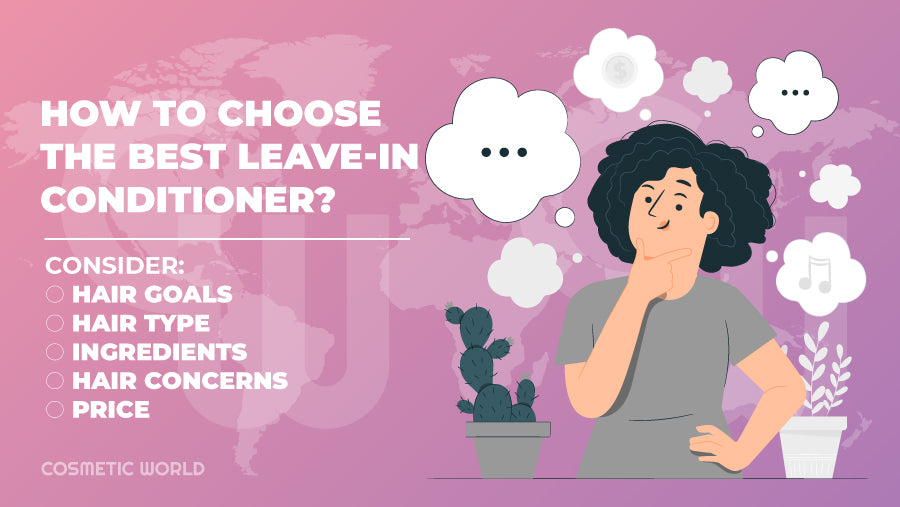
-
Hair goals: Decide what you want your leave-in conditioner to achieve, such as increased softness, shine, or manageability, and choose a product that will help you achieve them.
-
Hair type: Make sure the conditioner you choose is specifically formulated for your hair type, such as curly, dry, damaged, or oily.
-
Ingredients: Choose a leave-in conditioner whose ingredients are suitable for your hair type and concerns. For instance, if your hair is dry, look for a leave-in conditioner containing hydrating ingredients like argan oil or glycerin. Shea butter or coconut oil are two ingredients that can define and enhance curls.
-
Hair concerns: Think about any issues you have with your hair, like frizz, split ends, or color fading, and look for a leave-in conditioner that addresses them.
-
Price: Choose a leave-in conditioner that fits your budget.
You can also ask your hair stylist for recommendations on the best leave-in conditioner for your hair type.
Key benefits of leave-in conditioner
For me, leave-in conditioner has been a game-changer. This isbecause it has improved my dry, damaged hair's manageability, softness, and overall health. Before using leave-in conditioner, my hair often looked dull and lifeless and was prone to frizz and tangles. Incorporating leave-in conditioner into my hair care routine resulted in a noticeable improvement in my hair's texture and appearance. Moreover, it is easier to manage and style, as it is softer, smoother, and nourished. Leave-in conditioner has improved the health and appearance of my hair. Depending on your hair type, it can provide a number of benefits for the hair, including:
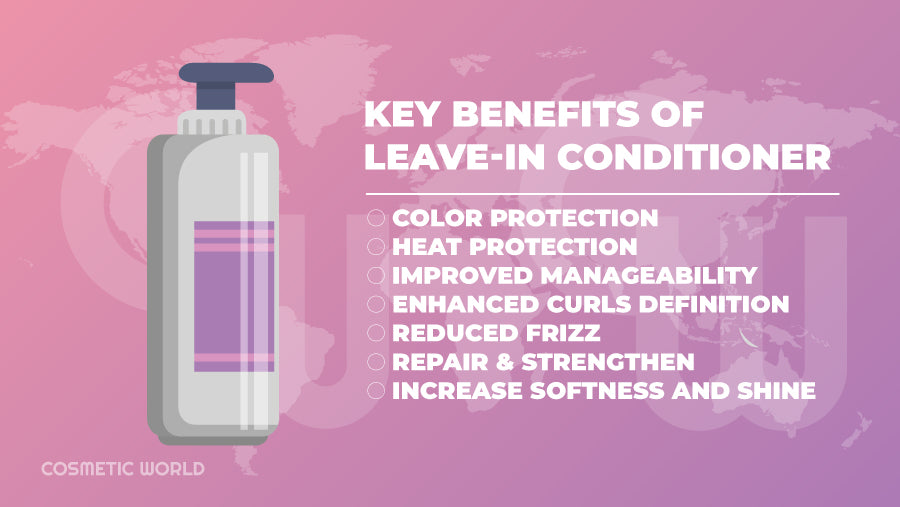
-
Added color protection: Some leave-in conditioners contain ingredients that can help to protect the color of dyed hair and prevent fading.
-
Heat protection: Many leave-in conditioners contain ingredients that can prevent heat damage from styling tools, such as hair dryers.
-
Improved manageability: Leave-in conditioner can make brushing and styling easier by detangling the hair.
-
Enhanced curl definition: Leave-in conditioner can help to define and enhance curls, making them more bouncy.
-
Reduced frizz: Leave-in conditioner can reduce frizz and flyaways, making hair look smoother and more polished.
-
Repair and strengthen: Conditioned hair can be repaired and strengthened, leading to healthier and more resilient locks.
-
Increased softness and shine: Leave-in conditioner helps moisturize the hair, resulting in softer, smoother, and shinier tresses.
Overall, the conditioner can help to improve the health and appearance of the hair. It can also make it more manageable, soft, and shiny.
Does Leave-In conditioner help hair grow?
No scientific evidence supports the claim that leave-in conditioners stimulate hair growth or prevent hair loss directly. The hair growth is largely determined by genetics and overall health. Other factors also matter such as age, hormonal changes, and certain medical conditions. If you want to explore more about hair loss prevention, I’ve made an article called “How to prevent hair loss”, that you can check out.
The use of a leave-in conditioner can, however, help improve the hair's health. Moreover, can ake it softer, smoother, and less prone to breakage by moisturizing and nourishing it. By reducing breakage, a leave-in conditioner can help to maintain the length of the hair and give the appearance of healthier hair.
When to apply the product?
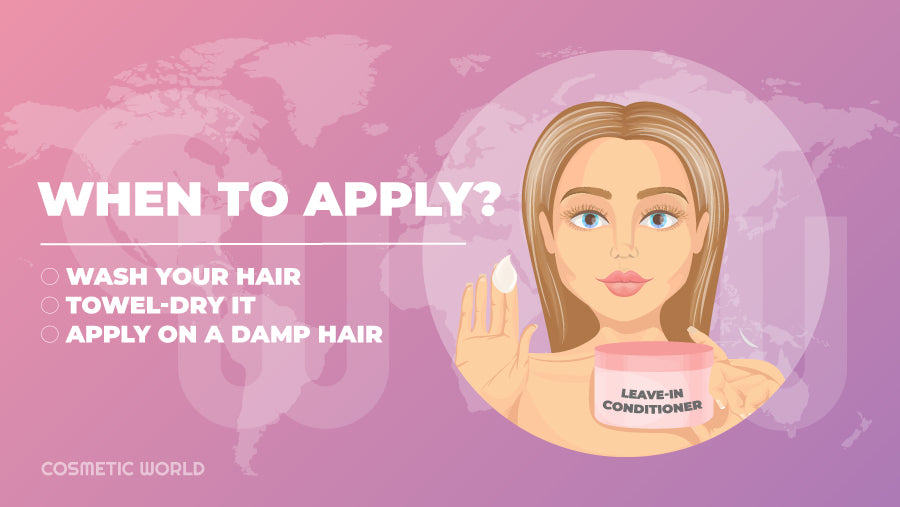
As I said above in Step 2 of “How to use leave-in conditioner” you typically appliy it on the hair after washing and towel-drying. Once your wash your hair, gently towel-dry it to remove excess moisture. It is important not to rub the hair too harshly with the towel, as this can cause damage and breakage. After you dry your hair with towel, apply the product.
Do you use leave-in conditioner on wet or dry hair?
It's better to apply the conditioner to a damp hair (slightly wet hair). That will help your hair shaft to absorb it more easily. If you apply it on dry hair, that may reduce the effectivness of the product. This may make the hair seem greasy or heavy.
Using the conditioner correctly requires following the directions on the packaging. It's also important to use only the amount, recommended for your length and thickness of hair.
Can you use leave-in conditioner every day?
Yes, you can use it every day, as long as you pick a product that suits your hair type. It's also important that you follow the directions on the box. In spite of this, excessive use of any hair care product, including this type of conditioner, can cause buildup and weight the hair down, resulting in greasy or heavy hair.
What is the difference between regular conditioner and leave-in conditioner?
Leave-in conditioners and traditional conditioners differ mainly in how they are used and how long they are left on. Traditional conditioner (rinse-out conditioner) is applied to the hair after shampooing and is usually left on the hair for a few minutes before being rinsed out. On the other hand, leave-in conditioners are applied to the hair after shampooing and are not rinsed out. Leaving it in the hair provides ongoing styling and conditioning benefits.

There is also a difference in consistency and formulation between both conditioners. As traditional conditioners are designed to be rinsed out after a short period of time, they are thicker and more concentrated than leave-in conditioners. Meanwhile, leave-ins, are designed to be left on the hair for an extended period of time That's why they generally feel lighter and have a more fluid consistency.
Generally speaking, traditional conditioners help with quick boost of conditioning, while leave-in conditioners provide ongoing conditioning and styling. Conditioners of both types can be beneficial for hair, depending on the user's specific needs and concerns.
Is it safe to use leave-in conditioner?
There are no known serious side effects associated with leave-in conditioners when used on hair. However, there are a few precautions to keep in mind when using the product:

-
Allergic reactions: As I mentioned in the article “Safe Hair Dye”, it is possible to have an allergic reaction to the ingredients in any hair product. If you have sensitive skin or have experienced allergic reactions to hair care products in the past, it is a good idea to do a patch test on a small area of your skin before using a leave-in conditioner. If you experience redness, itching, or other signs of irritation after using the product, stop using it immediately and consult a healthcare professional.
-
Overuse: It is important to use a leave-in conditioner as directed and to use only the recommended amount for your hair length and thickness. Using too much of the product can weigh the hair down and make it greasy or heavy.
-
Interactions with other products: If you are using other hair care products, such as styling products or heat-styling tools, it is important to follow the instructions on the product labels and to use caution to avoid damaging the hair.
Is it safe to use leave-in conditioner on colored hair?
As long as you choose a leave-in conditioner formulated for color-treated hair and use it as directed, it is safe to use on colored hair. You can nourish and protect colored hair and even make it it softer, smoother, and more vibrant.
Will the leave-in conditioner Leave Behind Any Residue?
Because leave-in conditioners are designed to remain in the hair for ongoing conditioning and styling benefits, some residue may be left behind. It will, however, depend on the particular conditioner you are using and the amount you apply to your hair.
There are leave-in conditioners that are lightweight and non-greasy, leaving little or no residue behind. There are other conditioners that are heavier and more nourishing, and they may leave a noticeable residue on the hair.
Conclusion:
In contrast to traditional conditioners, leave-in conditioners are applied to the hair after washing and left in rather than rinsed out.
The product improves the manageability, softness, and overall health of the hair. This treatment can benefit a variety of hair types and concerns, including dry, damaged, curly, frizzy, or fine hair.
When using leave-in conditioner, follow the instructions on the product label and apply only the amount recommended for your hair length and thickness. Distribute the conditioner evenly through your hair, avoiding the roots, using a wide-tooth comb or brush. After applying the leave-in conditioner, you can style your hair as you wish, but try to avoid heat styling.


